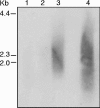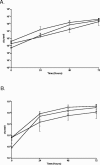Identification of Legionella pneumophila-specific genes by genomic subtractive hybridization with Legionella micdadei and identification of lpnE, a gene required for efficient host cell entry
- PMID: 16495539
- PMCID: PMC1418643
- DOI: 10.1128/IAI.74.3.1683-1691.2006
Identification of Legionella pneumophila-specific genes by genomic subtractive hybridization with Legionella micdadei and identification of lpnE, a gene required for efficient host cell entry
Abstract
Legionella pneumophila is a ubiquitous environmental organism and a facultative intracellular pathogen of humans. To identify genes that may contribute to the virulence of L. pneumophila, we performed genomic subtractive hybridization between L. pneumophila serogroup 1 strain 02/41 and L. micdadei strain 02/42. A total of 144 L. pneumophila-specific clones were sequenced, revealing 151 genes that were absent in L. micdadei strain 02/42. Low-stringency Southern hybridization was used to determine the distribution of 41 sequences, representing 40 open reading frames (ORFs) with a range of putative functions among L. pneumophila isolates of various serogroups as well as strains of Legionella longbeachae, L. micdadei, Legionella gormanii, and Legionella jordanis. Twelve predicted ORFs were L. pneumophila specific, including the gene encoding the dot/icm effector, lepB, as well as several genes predicted to play a role in lipopolysaccharide biosynthesis and cell wall synthesis and several sequences with similarity to virulence-associated determinants. A further nine predicted ORFs were in all L. pneumophila serotypes tested and an isolate of L. gormanii. These included icmD, the 5' end of a pilMNOPQ locus, and two genes known to be upregulated during growth within macrophages, cadA2 and ceaA. Disruption of an L. pneumophila-specific gene (lpg2222 locus tag) encoding a putative protein with eight tetratricopeptide repeats resulted in reduced entry into the macrophage-like cell line, THP-1, and the type II alveolar epithelial cell line, A549. The gene was subsequently renamed lpnE, for "L. pneumophila entry." In summary, this investigation has revealed important genetic differences between L. pneumophila and other Legionella species that may contribute to the phenotypic and clinical differences observed within this genus.
Figures




Similar articles
-
A specific genomic location within the icm/dot pathogenesis region of different Legionella species encodes functionally similar but nonhomologous virulence proteins.Infect Immun. 2004 Aug;72(8):4503-11. doi: 10.1128/IAI.72.8.4503-4511.2004. Infect Immun. 2004. PMID: 15271909 Free PMC article.
-
Heterogeneity in intracellular replication and cytopathogenicity of Legionella pneumophila and Legionella micdadei in mammalian and protozoan cells.Microb Pathog. 1999 Nov;27(5):273-87. doi: 10.1006/mpat.1999.0308. Microb Pathog. 1999. PMID: 10545255
-
Role for the Ankyrin eukaryotic-like genes of Legionella pneumophila in parasitism of protozoan hosts and human macrophages.Environ Microbiol. 2008 Jun;10(6):1460-74. doi: 10.1111/j.1462-2920.2007.01560.x. Epub 2008 Feb 14. Environ Microbiol. 2008. PMID: 18279343
-
Protein secretion in Legionella pneumophila and its relation to virulence.FEMS Microbiol Lett. 2004 Sep 15;238(2):273-9. doi: 10.1016/j.femsle.2004.07.056. FEMS Microbiol Lett. 2004. PMID: 15358411 Review.
-
Pathogenicity of Legionella pneumophila.Int J Med Microbiol. 2001 Nov;291(5):331-43. doi: 10.1078/1438-4221-00139. Int J Med Microbiol. 2001. PMID: 11727817 Review.
Cited by
-
Legionella pneumophila type II secretome reveals unique exoproteins and a chitinase that promotes bacterial persistence in the lung.Proc Natl Acad Sci U S A. 2006 Dec 12;103(50):19146-51. doi: 10.1073/pnas.0608279103. Epub 2006 Dec 5. Proc Natl Acad Sci U S A. 2006. PMID: 17148602 Free PMC article.
-
Molecular Detection of Legionella: Moving on From mip.Front Microbiol. 2010 Nov 11;1:123. doi: 10.3389/fmicb.2010.00123. eCollection 2010. Front Microbiol. 2010. PMID: 21687766 Free PMC article.
-
Identification and Characterization of msf, a Novel Virulence Factor in Haemophilus influenzae.PLoS One. 2016 Mar 15;11(3):e0149891. doi: 10.1371/journal.pone.0149891. eCollection 2016. PLoS One. 2016. PMID: 26977929 Free PMC article.
-
Sel1 repeat protein LpnE is a Legionella pneumophila virulence determinant that influences vacuolar trafficking.Infect Immun. 2007 Dec;75(12):5575-85. doi: 10.1128/IAI.00443-07. Epub 2007 Sep 24. Infect Immun. 2007. PMID: 17893138 Free PMC article.
-
Legionella pneumophila type II secretion dampens the cytokine response of infected macrophages and epithelia.Infect Immun. 2011 May;79(5):1984-97. doi: 10.1128/IAI.01077-10. Epub 2011 Mar 7. Infect Immun. 2011. PMID: 21383054 Free PMC article.
References
-
- Alli, O. A. T., S. Zink, K. N. von Lackum, and Y. Abu-Kwaik. 2003. Comparative assessment of virulence traits in Legionella spp. Microbiology 149:631-641. - PubMed
-
- Ausubel, F. M., R. Brent, R. E. Kingston, D. D. Moore, J. G. Seidman, J. A. Smith, and K. Struhl. 1995. Current protocols in molecular biology. John Wiley and Sons, Inc., New York, N.Y.
Publication types
MeSH terms
Substances
LinkOut - more resources
Full Text Sources
Molecular Biology Databases

